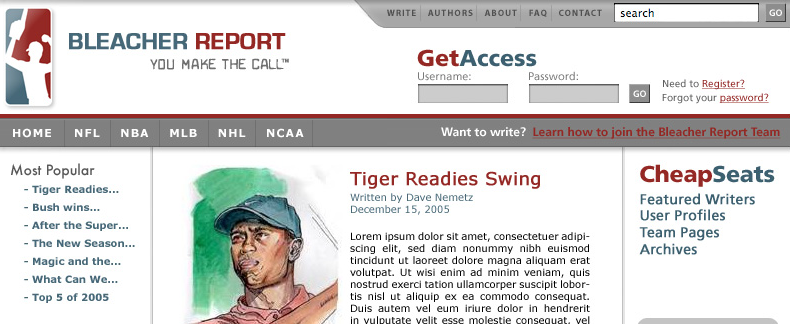People often ask me how Bleacher Report found our first writers.
B/R went through three distinct phases:
- The concept started as an amateur sports site run by a group of friends.
- While still at an early stage, the idea pivoted into an online community for sports fans, driven by user-generated content.
- Over several years, the site evolved into the professional sports media company it's known as today.
This post focuses on the first two phases.
I'll explain how a handful of friends just out of college started a sports blog. Then how we saw a bigger opportunity to build a community of fans, and brought the first members into that group.
"The Open Source Sports Network"
We first started dreaming up the idea for Bleacher Report in mid-2005 as recent college grads. The first B/R site launched about a year later.
The earliest discussions of Bleacher Report imagined the site as a collective sports blog. My co-founders and our extended group of friends, all huge sports nerds, would contribute the writing. This sounded like a fun project. But it also felt like we were ignoring a bigger opportunity.
This was the dawn of the Web 2.0 era. Believe it or not, Wikipedia had just become a big deal. New community-driven sites like Digg and Reddit were gaining steam. Blogging was still considered a fad.
The idea that communities of people were creating content on the internet for free was kind of radical.
Seizing on those trends, I suggested we open B/R up. Rather than a sports blog amongst friends, we made it a place where any diehard fan could join a community of other fans and publish their opinions.
Riffing on a suggestion from my dad, we dubbed it, "The Open Source Sports Network". Hilariously cheesy in hindsight. But hey, Web 2.0 was all the rage. This fit right in.
The only problem: how to build a community of writers?
Early days and bad takes
When we first launched the site, our group of friends contributed all the writing. We still had grander designs on building a community, but the site was still for all intents and purposes a group blog.
We would each write about the sports teams and stories that most interested us. And over time we recruited other friends and acquaintances to post as well.
This led to some hilariously bad takes. Like this article where I panned the San Francisco Giants selection of Madison Bumgarner in the MLB Draft.
Bumgarner would of course go on to lead the Giants to three World Series championships and win a World Series MVP. Not my strongest contribution. But then again, even the experts get it wrong a lot of the time.
And that was the point.
We believed that diehard fans like us could contribute sports opinion and analysis just as valid as the so-called experts. But we had tapped out our networks of people interested in writing.
We had to figure out how to build a community of people we didn't already know IRL. So through trial and error, we looked to the web to find fans to join our new community.
Spreading the word
We started with word of mouth. We blasted emails to friends, family and anyone we knew asking them to send people our way who were big sports fans and interested in writing.
Here's part of the email we sent out:

A lot of our friends laughed it off. I'm sure many more privately rolled their eyes at what we were doing. But a handful signed on, or forwarded the emails to friends who decided to try it out.
As word spread, we got our first new sign-ups to the site. We treated each new member like a quasi-celebrity. They got the royal treatment being onboarded to B/R. We lauded every contribution with praise and constructive feedback.
This was the first moment I felt like Bleacher Report could turn into something. Complete strangers (or at least second-degree connections) had joined our website and started to write.
Still, we had to keep adding fuel to the fire to build a thriving community.
Fake it 'til you make it
As our new writers cautiously dipped their toes in the water, we recognized the need to create a feeling of momentum in the community.
That's when Ryan Alberti, one of the first friends of ours to come onboard, hit on it:
Multiple personalities.
Ryan was one of the smartest people we knew, a Princeton scholar, and gridiron standout at our high school. And also one of the most unique minds in existence. He shaped Bleacher Report in countless ways in the early days.
One particularly influential choice of Ryan's was to publish under a variety of assumed names like Joe Cottage and Nick Nickel. Each persona had a different writing style and POV. Sometimes they feuded with each other. My co-founders and I followed suit.
Our small community started to seem much more active and alive. This encouraged new writers to jump in and participate. The founders of Reddit have copped to doing something similar to kickstart their community in the early days.
As they say, "Fake it 'til you make it." A cliché, but it works.
Unbundling the platform
After we exhausted our personal networks, we had to look elsewhere for growth. So we decided to unbundle the most dominant community platform of the era.
Yep, Craigslist.
We posted in the 'Writing Gigs' section in various cities. Our posts promoted Bleacher Report as a place for amateur sportswriters to publish their work. They resulted in hundreds of responses.
We'd respond personally and walk each person through the process of joining B/R and writing their first post. The vast majority of our initial community came from Craigslist.
We took a calculated risk posting on what was essentially a job board to build a community. Our message made clear there was no pay involved, and no promise of future pay. Instead, we offered a place to publish and the support of a community.
We got some nasty messages even back then. In many ways we fell squarely on the wrong side of the debate about fair compensation for creative work. But we were also an unknown sports site founded by inexperienced recent grads with no funding and no budget. Necessity was the mother of invention.
We continued to debate for years about whether to be a UGC community or a professional site. Eventually we switched to the latter. But that story is for a future post.
Bundling the bloggers
Seeing the promise of Craigslist, we set our sights on an even more expansive space: The blogosphere.
Blogging was still brand new. Deadspin had launched in 2005, a year before B/R. SB (neée SportsBlog) Nation was still a fledgling operation with only a handful of blogs under their banner. And then, like now, there were millions of independent blogs of varying quality publishing in the chaotic open web.
B/R sought to bring order to the chaos by inviting solo bloggers to join our community. Utilizing Google, blogrolls, and a newfangled blog search engine called Technorati, we assembled extensive, categorized lists of all the sports blogs we could find.
Then we started reaching out to them one-by-one with appeals to join our community. Eventually we found ways to automate this manual process.
Blogger outreach was another huge part of our growth in the early days. We reasoned that most bloggers were toiling in obscurity. They received no pay and little recognition for their work. We couldn't solve the pay part. But we could give them a growing community to interact with and a larger audience as B/R grew.
Yeah, but what's your paid social strategy?
Having nailed bundling and unbundling, my co-founders and I moved on to another tried-and-true digital growth tactic: paid marketing.
Initially, we had the idea to advertise in the sports sections of college newspapers.
We figured that college students, like we had recently been, were prime candidates to join a sportswriting community. But after some fruitless searching and outreach, we learned that the college papers of the time were shockingly inept when it came to accepting digital ads.
So we switched gears to a fairly new social platform that at that point catered exclusively to college students: Facebook.
Long before being an unstoppable juggernaut with the power to destabilize society as we know it, Facebook was a glorified message board for college students without a revenue model in sight. Until they launched a basic self-serve advertising product called "Facebook Flyers."
The format took inspiration from those paper flyers you would see hanging on bulletin boards around campus. The all-text ads resembled Google Adwords and appeared on the sidebar of the Facebook home page. You could only target them by college at the time. And they were incredibly cheap.
So we used a few hundred bucks to buy flyers targeted to big sports schools. College sports fans interested in writing started signing up. Eventually Facebook opened up targeting by interest and our success increased. Soon we were getting dozens of new sign-ups per day from Facebook flyers off of a very low spend.
By the second half of 2007, Bleacher Report's community was thriving. We had started a year before as a small sports blog run by friends, publishing a few posts a day. A little over a year later, we had a community of hundreds of fans publishing dozens of new articles per day.
Looking back on this time, there was no silver bullet that got our community going. Most of the tactics we used started as blind guesses. They involved a lot of manual work that couldn't really be automated. If they worked, we refined them and built processes around them.
But being efficient wasn't the point. When you're starting out, the most important thing to do is to find your 1,000 true fans. To build a core that will stick with you while you validate your ideas and iterate on your product. Getting to that point made all the trial and error worth it.
After all that work, Bleacher Report's audience had grown and soon eclipsed 100,000 monthly unique visitors. This seemed like an astronomical number at the time. But we soon realized we had a long, long way to grow until B/R could be viable as a business.
Still, our efforts of the first year had paid off. We started with nothing but an idea. Through experimentation, we built a viable community with a growing audience.
So we pressed on, confident that we could achieve the next milestones on the horizon.



